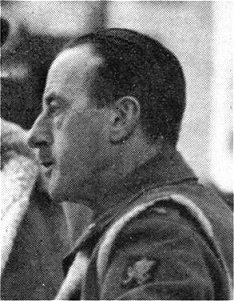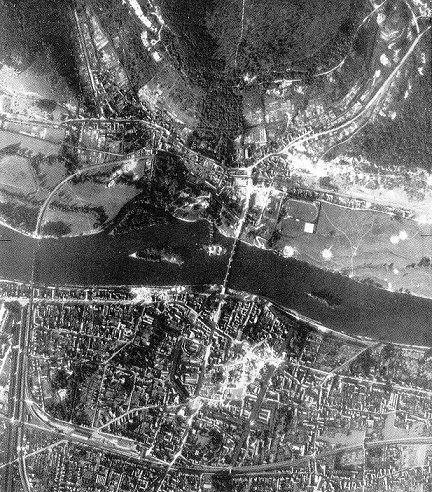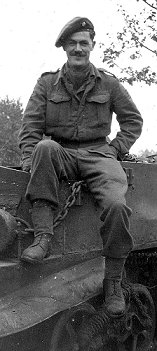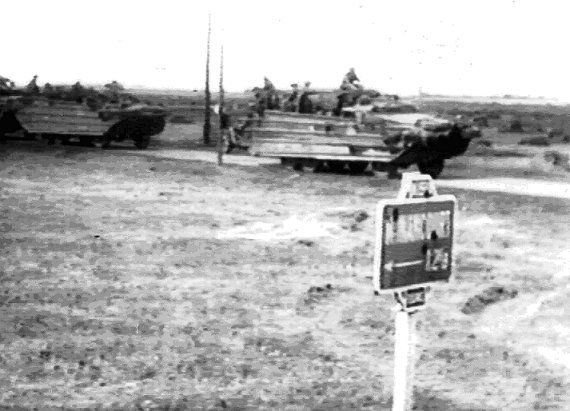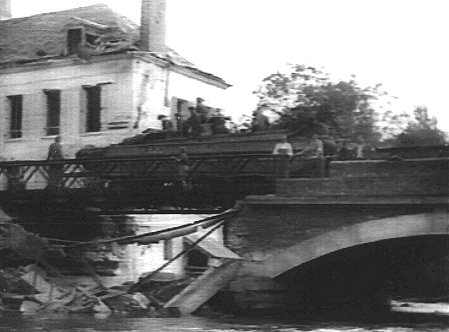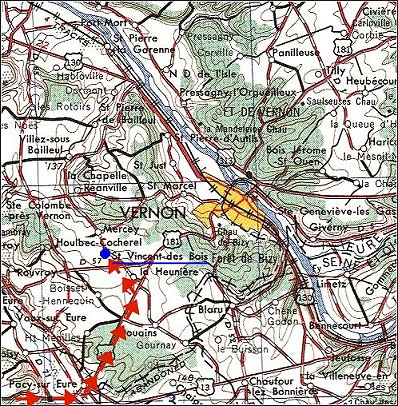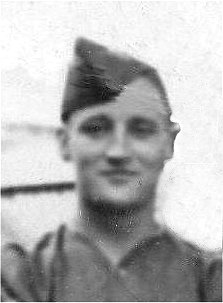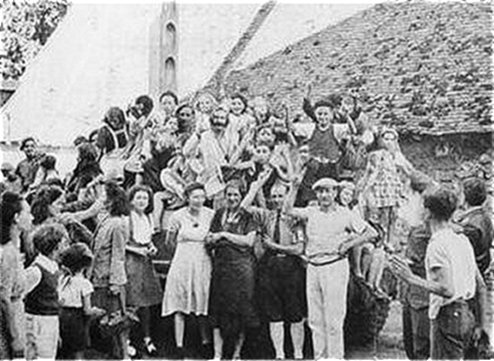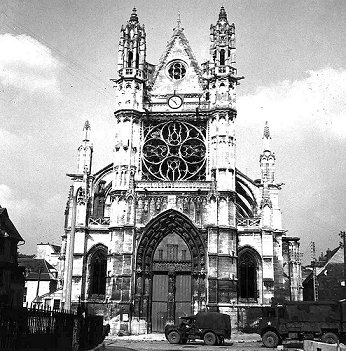1st Battalion Worcestershire Regiment - North West Europe 1944
VERNON - The River Seine Crossing (25th to 28th August 1944) - Part 2
Build up to Operation "Neptune"
By the 22nd August 1944 the war in Normandy had moved on and the German resistance in the Falaise pocket finally ended with some 70,000 German troops either killed or captured, and the remaining German forces in full retreat across the River Seine. At this time the American 79th Division had already reached the banks of the Seine and were advancing on Paris. The Second British Army was also advancing to the Seine, with 30 Corps on the right and 12 Corps on the left. For the push through France and Belgium, Lieut.-General Horrocks, 30 Corps Commander, decided to use two armoured divisions and the 50th Infantry Division for this rapid advance. The 43rd (Wessex) Infantry Division was given the key task of preparing the way across the River Seine. On the evening of the 22nd August 1944, Major-General G. Ivor Thomas, commanding the 43rd Wessex Division, received his instructions from the Lieut.-General Horrocks, to force a crossing over the River Seine at Vernon, some 80 Km north west of Paris, and to form a bridgehead of sufficient depth to allow the remainder of 30 Corps to pass though. Later the same evening Major-General Ivor Thomas, informed his Brigade Commanders that the 43rd Wessex Division had been given the task of being the first British Division to assault the River Seine. |
Maj.-Gen. G. Ivor Thomas |
The 129 Infantry Brigade, commanded by Brigadier G. H. L. Mole, which would be reinforced with the 1st Battalion Worcestershire Regiment of 214 Infantry Brigade had been chosen to make the assault crossing at Vernon. The operation was given the code name “Neptune”.
At this time the Worcesters were still at Berjou resting, where they had been for the last 6 days, after the weeks of fighting in Normandy. During this rest period some of the men were given the opportunity to be taken back to Arromanches (the landing beaches) and in a barn there they were entertained by E.N.S.A. - Corporal Bill Goulds (signals platoon) remembers going and recalls that a Mr. Pastry was the star of this outfit.
Aerial view of Vernon taken 14th August 1944, |
On the morning of the 22nd, the men were informed by their commanding officer, Lieut.-Colonel Osborne-Smith that they should be ready to move the next day. So it was that after breakfast on the 23rd August 1944 the 1st Battalion Worcestershire Regiment formed up on the streets of Berjou, boarded their T.C.V. (troop carrying vehicles) and joined the three battalions of the 129th Infantry Brigade. At 10.15 hours they were on the move. |
|
Captain Jock Bannister (Mortar Platoon Commander) recalls: Private Tom Dutton recalls: “Every village and town we journeyed through, the inhabitants lined the streets waving flags, throwing flowers, issuing drinks, mile after mile it was the same story. In return we offered cigarettes, sweets, chocolate - to see British soldiers so bedecked with flowers was unbelievable; such emotion was roused on both sides, the sheer flood of happiness was unreal.” |
Captain 'Jock' Bannister |
|
The welcome by the local French villagers put the troops in great heart as the long column passed through the towns and villages. In the afternoon the Battalion curled up off the main axis to the south in the picturesque village of Louge-sur-Maire. It was here, in the largest house in the village where Battalion Headquarters had established itself, that a preliminary "Orders" Group was called. The pending operation was outlined and maps were issued. The troop carrying vehicles in which the Battalion had been transported were withdrawn and late that night a column of D.U.K.W.S, arrived and were distributed to Companies. There was a temporary lapse in the weather and from early evening until the following dawn it poured with rain, turning the hitherto dust-carpeted lanes into small rivers of squelching mud. However, by 12.00 hours on the next day (24th August) as the column slowly uncoiled itself and moved east again along the axis, the sun had broken through once more and the rapidly clearing sky forecast a fresh spell of prolonged heat.
|
Battalion travelling in D.U.K.W.’s heading for Vernon |
Crossing the damaged bridge over the river at Pacy-sur-Eure |
By approximately 20.00 hours the second stage of the journey was completed. The Battalion spent the night in the small village of Le Rue Bertrou in the area of Breteuil, and the next morning at 11.45 hours, following another "O" Group, the column once more took the road and raced for Vernon. And race is precisely what it did. From now on speed was the essence of the whole operation, in addition to which the Divisional Column had to cut clean across the American axis, for which it had been allotted only four hours. After a fast and dusty drive, slowed only by cratered roads, the Battalion arrived at its holding area at the village of St. Vincent-des-Bois, about three miles from Vernon. It was now mid-afternoon (25th August) and "H" hour for the first wave of the Seine crossing at Vernon was planned for 19.00 hours. Whilst a hot meal was being prepared and issued, the Commanding Officer, Lieut.-Colonel R.E. Osborne-Smith, and his ‘O’ Group staff went on ahead to reconnoitre the north bank of the River Seine at Vernon in preparation for the crossing. |
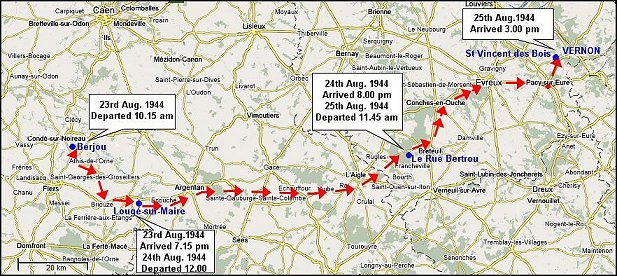
Route taken by the Worcesters from Berjou to St. Vincent des Bois (23rd to 25th August 1944)
1st Worcestershires move to St. Vincent-des-Bois |
Using alleyways and crossing gardens, the small group reached the edge of the river without revealing its presence to the Germans on the opposite bank of the Seine. They were able to pinpoint the Company objectives which had been studied previously on aerial photographs. |
|
Sergt. Jim Norton recalls: “As I was still acting Signals Officer at the time, I went forward with the C.O as part of his ‘O’ Group to view the actual crossing and to make the plans. My first thought when I saw it was what a wonderful place to defend, why the hell do we attack here!!” In Vernon there were a few troops of an American reconnaissance unit who had arrived a few days earlier. The Germans had already pulled back across the river. The town was full of local resistance movement, the strongest and best equipped of whom were the railwaymen, having seized the barracks and barricaded themselves inside.
|
Sgt. Jim Norton |
|
Vernon people welcome the British troops
|
Collégiale Notre Dame (Our Lady Collegiate Church) Vernon (IWM BU204) |
The River Seine, 200 yards wide at this point, was calm and grey. On the other side was the village of Vernonnet, at the foot of a high wooded escarpment which rose above it, dwarfing the church and its thin spire to diminutive proportions. Nothing could be seen stirring on the enemy side and only the occasional wild and nervous bursts of spandau fire indicated his restlessness. The centre span of the blown road bridge sagged sadly into the water.
Back in the town there was a feverish but silent activity as the leading Battalions unloaded their storm boats and assembled their men. French civilians came out to watch, assist and advise, full of information, high spirits and chatter.
By the time the Commanding Officer and his "O" Group made its way back to the Battalion, the men were already in the streets of Vernon near the church. It was now 18.30 hours.
The men of the Worcesters were now resting and waiting along Rue Carnot in preparation for the assault across the Seine.
The plan was for 129 Infantry Brigade, with the 1st Worcesters under their command, to attack across the Seine in two waves of two Battalions each. The first wave was the 5th Wiltshires on the right and the 4th Somersets on the left; and the second, 1st Worcestershires behind 5th Wiltshires, and 4th Wiltshires behind 4th Somersets.
The 1st Worcestershires Battalion was to form the centre of the bridgehead with its perimeter far forward on the high ground, above the river.

Damaged Road Bridge looking from Vernonnet side - Vernon on the left

